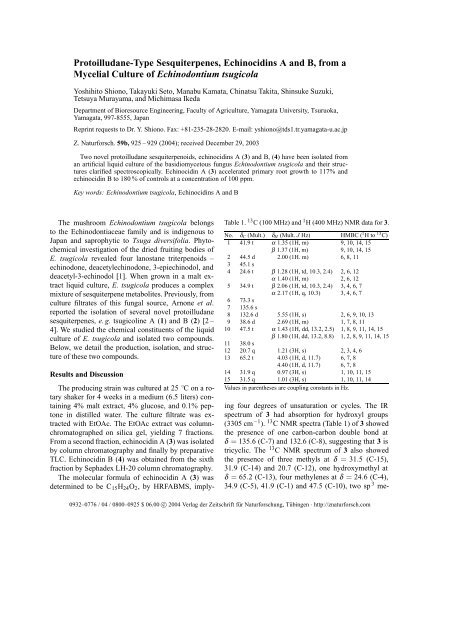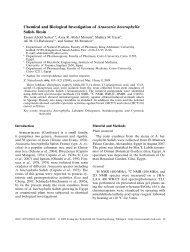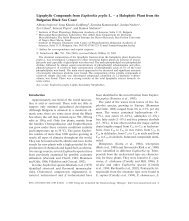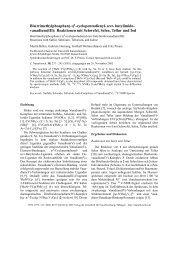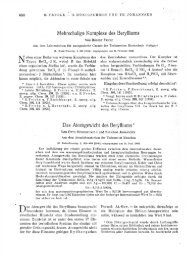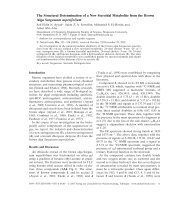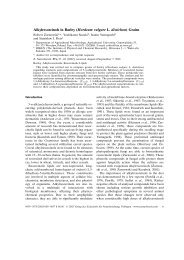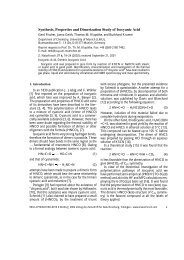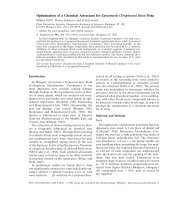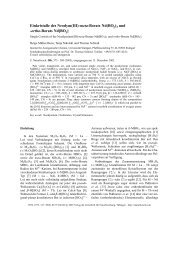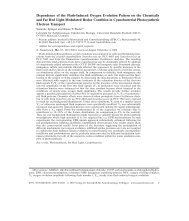Protoilludane-Type Sesquiterpenes, Echinocidins A and B, from a ...
Protoilludane-Type Sesquiterpenes, Echinocidins A and B, from a ...
Protoilludane-Type Sesquiterpenes, Echinocidins A and B, from a ...
You also want an ePaper? Increase the reach of your titles
YUMPU automatically turns print PDFs into web optimized ePapers that Google loves.
<strong>Protoilludane</strong>-<strong>Type</strong> <strong>Sesquiterpenes</strong>, <strong>Echinocidins</strong> A <strong>and</strong> B, <strong>from</strong> a<br />
Mycelial Culture of Echinodontium tsugicola<br />
Yoshihito Shiono, Takayuki Seto, Manabu Kamata, Chinatsu Takita, Shinsuke Suzuki,<br />
Tetsuya Murayama, <strong>and</strong> Michimasa Ikeda<br />
Department of Bioresource Engineering, Faculty of Agriculture, Yamagata University, Tsuruoka,<br />
Yamagata, 997-8555, Japan<br />
Reprint requests to Dr. Y. Shiono. Fax: +81-235-28-2820. E-mail: yshiono@tds1.tr.yamagata-u.ac.jp<br />
Z. Naturforsch. 59b, 925 – 929 (2004); received December 29, 2003<br />
Two novel protoilludane sesquiterpenoids, echinocidins A (3) <strong>and</strong> B, (4) have been isolated <strong>from</strong><br />
an artificial liquid culture of the basidiomycetous fungus Echinodontium tsugicola <strong>and</strong> their structures<br />
clarified spectroscopically. Echinocidin A (3) accelerated primary root growth to 117% <strong>and</strong><br />
echinocidin B to 180 % of controls at a concentration of 100 ppm.<br />
Key words: Echinodontium tsugicola, <strong>Echinocidins</strong> A <strong>and</strong> B<br />
The mushroom Echinodontium tsugicola belongs<br />
to the Echinodontiaceae family <strong>and</strong> is indigenous to<br />
Japan <strong>and</strong> saprophytic to Tsuga diversifolia. Phytochemical<br />
investigation of the dried fruiting bodies of<br />
E. tsugicola revealed four lanostane triterpenoids –<br />
echinodone, deacetylechinodone, 3-epiechinodol, <strong>and</strong><br />
deacetyl-3-echinodol [1]. When grown in a malt extract<br />
liquid culture, E. tsugicola produces a complex<br />
mixture of sesquiterpene metabolites. Previously, <strong>from</strong><br />
culture filtrates of this fungal source, Arnone et al.<br />
reported the isolation of several novel protoilludane<br />
sesquiterpenes, e. g. tsugicoline A (1) <strong>and</strong> B (2) [2–<br />
4]. We studied the chemical constituents of the liquid<br />
culture of E. tsugicola <strong>and</strong> isolated two compounds.<br />
Below, we detail the production, isolation, <strong>and</strong> structure<br />
of these two compounds.<br />
Results <strong>and</strong> Discussion<br />
The producing strain was cultured at 25 ◦ C on a rotary<br />
shaker for 4 weeks in a medium (6.5 liters) containing<br />
4% malt extract, 4% glucose, <strong>and</strong> 0.1% peptone<br />
in distilled water. The culture filtrate was extracted<br />
with EtOAc. The EtOAc extract was columnchromatographed<br />
on silica gel, yielding 7 fractions.<br />
From a second fraction, echinocidin A (3) was isolated<br />
by column chromatography <strong>and</strong> finally by preparative<br />
TLC. Echinocidin B (4) was obtained <strong>from</strong> the sixth<br />
fraction by Sephadex LH-20 column chromatography.<br />
The molecular formula of echinocidin A (3) was<br />
determined to be C 15 H 24 O 2 , by HRFABMS, imply-<br />
Table 1. 13 C (100 MHz) <strong>and</strong> 1 H (400 MHz) NMR data for 3.<br />
No. δ C (Mult.) δ H (Mult. J Hz) HMBC ( 1 Hto 13 C)<br />
1 41.9 t α 1.35 (1H, m) 9, 10, 14, 15<br />
β 1.37 (1H, m) 9, 10, 14, 15<br />
2 44.5 d 2.00 (1H. m) 6, 8, 11<br />
3 45.1 s<br />
4 24.6 t β 1.28 (1H, td, 10.3, 2.4) 2, 6, 12<br />
α 1.40 (1H, m) 2, 6, 12<br />
5 34.9 t β 2.06 (1H, td, 10.3, 2.4) 3, 4, 6, 7<br />
α 2.17 (1H, q, 10.3) 3, 4, 6, 7<br />
6 73.3 s<br />
7 135.6 s<br />
8 132.6 d 5.55 (1H, s) 2, 6, 9, 10, 13<br />
9 38.6 d 2.69 (1H, m) 1, 7, 8, 11<br />
10 47.5 t α 1.43 (1H, dd, 13.2, 2.5) 1, 8, 9, 11, 14, 15<br />
β 1.80 (1H, dd, 13.2, 8.8) 1, 2, 8, 9, 11, 14, 15<br />
11 38.0 s<br />
12 20.7 q 1.21 (3H, s) 2, 3, 4, 6<br />
13 65.2 t 4.03 (1H, d, 11.7) 6, 7, 8<br />
4.40 (1H, d, 11.7) 6, 7, 8<br />
14 31.9 q 0.97 (3H, s) 1, 10, 11, 15<br />
15 31.5 q 1.01 (3H, s) 1, 10, 11, 14<br />
Values in parentheses are coupling constants in Hz.<br />
ing four degrees of unsaturation or cycles. The IR<br />
spectrum of 3 had absorption for hydroxyl groups<br />
(3305 cm −1 ). 13 C NMR spectra (Table 1) of 3 showed<br />
the presence of one carbon-carbon double bond at<br />
δ = 135.6 (C-7) <strong>and</strong> 132.6 (C-8), suggesting that 3 is<br />
tricyclic. The 13 C NMR spectrum of 3 also showed<br />
the presence of three methyls at δ = 31.5 (C-15),<br />
31.9 (C-14) <strong>and</strong> 20.7 (C-12), one hydroxymethyl at<br />
δ = 65.2 (C-13), four methylenes at δ = 24.6 (C-4),<br />
34.9 (C-5), 41.9 (C-1) <strong>and</strong> 47.5 (C-10), two sp 3 me-<br />
0932–0776 / 04 / 0800–0925 $ 06.00 c○ 2004 Verlag der Zeitschrift für Naturforschung, Tübingen · http://znaturforsch.com
926 Y. Shiono et al. · <strong>Echinocidins</strong> A <strong>and</strong> B <strong>from</strong> Echinodontium tsugicola<br />
Fig. 2. Selected NOE correlations for echinocidin A (3).<br />
Fig. 1. The structures of tsugicolines A (1) <strong>and</strong> B<br />
(2), echinocidin A (3), monoacetylechinocidin A (3a),<br />
echinocidin B (4), <strong>and</strong> diacetylechinocidin B (4a).<br />
thines at δ = 38.6 (C-9) <strong>and</strong> 44.5 (C-2) <strong>and</strong> three quaternary<br />
carbons, one of which was linked to oxygen<br />
at δ = 38.0 (C-11), 45.1 (C-3), <strong>and</strong> 73.3 (C-6). The<br />
1 H NMR spectrum (Table 1) of 3 showed three singlet<br />
methyls at δ = 0.97 (s, 3H, 14-H 3 ), 1.01 (s, 3H,<br />
15-H 3 ) <strong>and</strong> 1.21 (s, 3H, 12-H 3 ) <strong>and</strong> two protons of hydroxymethyl<br />
at δ = 4.03 (d, J = 11.7 Hz, 1H, 13-H 2 )<br />
<strong>and</strong> 4.40 (d, J = 11.7 Hz, 1H, 13-H 2 ), <strong>and</strong> a proton of<br />
a trisubstituted double bond at δ = 5.55 (s, 1H, 8-H).<br />
Detailed study of the 1 H- 1 H-COSY <strong>and</strong> HMQC spectra<br />
showed the presence of -C(4)H 2 -C(5)H 2 -[δ = 1.28<br />
(td, J = 10.3, 2.4 Hz, 1H, 4 β -H), 1.40 (m, 1H, 4 α-<br />
H), 2.06 (td, J = 10.3, 2.4 Hz, 1H, 5 β -H) <strong>and</strong> 2.17<br />
(q, J = 10.3 Hz, 1H, 5 α-H)] <strong>and</strong> -CH 2 (1)-CH(2)-<br />
CH(9)[-CH 2 (10)-]-CH(8)- [δ = 1.35 (m, 1H, 1 α-H),<br />
1.37 (m, 1H, 1 β -H), 2.00 (m, 1H, 2-H), 2.69 (m, 1H,<br />
9-H), 1.43 (dd, J = 13.2, 2.5 Hz, 1H, 10 α-H) <strong>and</strong><br />
1.80 (1H, dd, J = 13.2, 8.8 Hz, 10 β -H)] moieties.<br />
Based on these findings, 3 was deduced to be a protoilludane<br />
sesquiterpene. In the comparison with spectral<br />
data for a sesquiterpene isolated <strong>from</strong> Laurilia tsugicola<br />
(E. tsugicola), its 13 C NMR spectral data for C-1,<br />
C-2, C-3, C-10, C-11, C-12, C-13, C-14, <strong>and</strong> C-15 resembled<br />
that of tsugicoline A [1]. In the HMBC spec-<br />
trum of 3 (Table 1), HMBC correlations of 13-H 2 to<br />
C-6 <strong>and</strong> C-8, <strong>and</strong> 8-H to C-13 indicated that a double<br />
bond can be placed between C-7 <strong>and</strong> C-8. Signals of<br />
4-H 2 correlated with C-2, C-6, <strong>and</strong> C-12; signals of 5-<br />
H 2 with C-3 <strong>and</strong> C-7; <strong>and</strong> signals of 12-H 3 with C-2,<br />
C-3, C-4, <strong>and</strong> C-6, suggesting a planar structure for 3<br />
as shown in Fig. 1. The relative stereochemistry of 3<br />
was established by a nuclear Overhauser effect (NOE)<br />
difference experiment (Fig. 2) in which NOEs <strong>from</strong> 14-<br />
H 3 to 1 β -H, 14-H 3 to 10β -H, 14-H 3 to 2-H, 15-H 3 to<br />
1α-H, 15-H 3 to 10α-H, 15-H 3 to 8-H, <strong>and</strong> 9-H to 2-<br />
H. These results indicated a cis-juncture between cyclopentane<br />
<strong>and</strong> cyclohexene rings. The configuration<br />
at C-3 was elucidated to be α-CH 3 based on NOEs<br />
<strong>from</strong> 12-H 3 to 1-H 2 , 12-H 3 to 4α-H <strong>and</strong> 12-H 3 to 5α-<br />
H. In NOE experiments on monoacetate 3a, irradiation<br />
of 12-H 3 caused NOEs on 5α-H <strong>and</strong> 6-OH, thus establishing<br />
the cyclobutane / cyclohexene rings junction as<br />
cis, i. e., the relative structure of echinocidin A was 3.<br />
The stereostructure of 3 was similar to those of tsugicolines<br />
A (1)<strong>and</strong>B(2), whose absolute structures have<br />
been determined as a (2S,3R,9R)-configuration by application<br />
of the Horeau chirality rule [1]. The absolute<br />
configurations of hydrogen at C-2, C-9 <strong>and</strong> of a methyl<br />
at C-3 were therefore presumed to be the same as those<br />
of 1 <strong>from</strong> a biosynthetic pathway.<br />
Echinocidin B (4) showed spectral characteristics<br />
similar to those of 3. The molecular formula of 4,<br />
C 15 H 24 O 3 , was determined by HRFABMS, corresponding<br />
to one oxygen atom more than that of 3. The<br />
IR spectrum showed a hydroxyl group at 3322 cm −1 .<br />
The 1 H <strong>and</strong> 13 C NMR spectra (Table 2) of 4 correspond<br />
well to those of 3, except for the presence of<br />
an oxymethine signal [δ H = 4.29 (t, J = 8.8, 1H, 5-<br />
H), δ C = 75.9 (C-5)] in place of one methylene signal,<br />
indicating 4 was probably an oxygenated metabolite<br />
of 3. The location of a hydroxyl group at C-5 was established<br />
by HMBC (Table 2) in which methine (5-H)<br />
correlated with C-4, C-6, <strong>and</strong> C-7. Upon acetylation, 4
Y. Shiono et al. · <strong>Echinocidins</strong> A <strong>and</strong> B <strong>from</strong> Echinodontium tsugicola 927<br />
Table 2. 13 C (100 MHz) <strong>and</strong> 1 H (400 MHz) NMR data for 4.<br />
No. δ C (Mult.) δ H ( Mult. J Hz) HMBC ( 1 Hto 13 C)<br />
1 41.6 t β 1.26 (1H, t, 12.7) 3, 9, 10, 11, 14, 15<br />
α 1.35 (1H, m) 3, 9, 10, 11, 14, 15<br />
2 44.4 d 2.08 (1H, m) 1, 6, 8, 9, 11<br />
3 37.1 s<br />
4 35.6 t β 1.34 (1H, m) 2, 5, 12<br />
α 1.84 (1H, dd, 10.7, 8.8) 5, 12<br />
5 75.9 d 4.29 (1H, t, 8.8) 4, 6, 7<br />
6 77.8 s<br />
7 133.1 s<br />
8 134.8 d 5.68 (1H, s) 2, 6, 10, 13<br />
9 39.1 d 2.70 (1H, m) 1, 7, 10, 11<br />
10 47.5 t α 1.39 (1H, td, 13.7, 2.0) 1, 8, 11, 14, 15<br />
β 1.80 (1H, dd, 13.7, 8.3) 1, 8, 11, 14, 15<br />
11 38.0 s<br />
12 21.9 q 1.15 (3H, s) 2, 3, 4, 6<br />
13 64.9 t 4.20 (1H, d, 12.2) 6, 8<br />
4.41 (1H, d, 12.2) 6, 8<br />
14 31.7 q 0.97 (3H, s)* 1, 10, 11, 15<br />
15 31.9 q 0.96 (3H, s)* 1, 10, 11, 14<br />
Values in parentheses are coupling constants in Hz. * These values<br />
might be interchangeable.<br />
Fig. 3. Selected NOE correlations for diacetylechinocidin B<br />
(4a).<br />
gave diacetate 4a. In NOE experiments (Fig. 3), diacetate<br />
4a showed NOEs <strong>from</strong> 9-H to 2-H, 9-H to 14-H 3 ,<br />
14-H 3 to 10β -H, 15-H 3 to 1α-H, <strong>and</strong> 15-H 3 to 10α-<br />
H, indicating that the cyclopentane-cyclohexene ring<br />
junction was cis. It also required a cis juncture between<br />
cyclobutane <strong>and</strong> cyclohexene rings with α-12-H 3 <strong>and</strong><br />
an α−hydroxyl group at C-6 <strong>from</strong> NOEs observed<br />
<strong>from</strong> 9-H to 4β -H, 12-H 3 to 1α-H <strong>and</strong> 12-H 3 to 4α-H.<br />
The methine proton at C-5 was α-oriented, which was<br />
supported by an NOE <strong>from</strong> 12-H 3 to 5-H. These data<br />
let us to formulate the structure of echinocidin B (4)to<br />
be that shown in Fig. 1.<br />
Other protoilludane-derived sesquiterpenoids, i. e.,<br />
∆ 7 -protoilluden-6-ol <strong>from</strong> Fomitopsis insularis, [5]<br />
<strong>and</strong> neoilludol <strong>from</strong> Clitocybe illudens [6] have also<br />
been isolated but their activity not reported. Tsugicoline<br />
A (1) had allelopathic activity against Lepidium<br />
sativum [1]. The biological activity of 3 <strong>and</strong> 4 was<br />
examined via antimicrobial activity <strong>and</strong> lettuce bioassay.<br />
Compounds 3 <strong>and</strong> 4 were inactive against C<strong>and</strong>ida<br />
albicans ATCC 2019, Staphylococcus aureus NBRC<br />
13276, <strong>and</strong> Pseudomonas aeruginosa ATCC 15442 at<br />
a concentration of 100 µg / disk. With the lettuce<br />
seedling assay, 3 showed radicle elongation activity of<br />
117% <strong>and</strong> 4 180% of controls at a concentration of<br />
100 ppm.<br />
Experimental Section<br />
General experimental procedures<br />
Melting points (m. p.) data are uncorrected. Optical rotation<br />
was measured with a Horiba model SEPA-300 polarimeter,<br />
IR spectra were recorded with a JASCO J-20A<br />
spectrophotometer, <strong>and</strong> UV spectra were recorded with a<br />
Shimadzu UV mini-1240 instrument. Mass spectra were<br />
recorded with a JEOL JMS-700 instrument, <strong>and</strong> 1 H <strong>and</strong><br />
13 C NMR spectra were obtained with a JEOL EX-400 spectrometer.<br />
Chemical shifts are given on a δ (ppm) scale with<br />
TMS as an internal st<strong>and</strong>ard. Column chromatography was<br />
conducted on Sephadex LH-20 (Pharmacia) <strong>and</strong> silica gel 60<br />
(Kanto Chemical Co., Inc.). TLC was done on a precoated<br />
silica gel plate (Merck), <strong>and</strong> spots were detected by spraying<br />
10% vanillin in H 2 SO 4 followed by heating.<br />
Fungus <strong>and</strong> cultivation<br />
The strain of E. tsugicola used in this work was kindly<br />
supplied by Mori & Company, Ltd., Gunma, Japan. The<br />
mycelia were cultured in sixty five 500 ml-Sakaguchi flasks<br />
containing 100 ml of a medium consisting of 40 g of malt extract,<br />
40 g of glucose, <strong>and</strong> 1.0 g peptone per 1 liter of water.<br />
Each flasks was inoculated with some disks (5 mm i. d.) of<br />
the mycelia freshly grown on malt agar plates, <strong>and</strong> cultured<br />
at 25 ◦ C for 4 weeks on a rotary shaker (120 rpm).<br />
Extraction <strong>and</strong> isolation of echinocidins A <strong>and</strong> B<br />
After the incubation period, 6.5 liters of culture broth was<br />
separated <strong>from</strong> the mycelia by filtration. The culture filtrate<br />
was extracted with EtOAc. The organic layer was dried over<br />
anhydrous sodium sulfate, the solvent was evaporated to afford<br />
a brown residue (3.3 g). This crude extract was subjected<br />
to silica gel column chromatography with CHCl 3 -MeOH<br />
(98:2 <strong>and</strong> 95:5, v/v) to give seven fractions (fr. 1.1 – 1.7).<br />
Fr. 1.2 was chromatographed on silica gel column by eluting<br />
with hexane-EtOAc (2:1), followed by preparative TLC<br />
with CHCl 3 -MeOH (94:6, v/v) to afford echinocidin A (3,<br />
64.9 mg). Fr. 1.6 was separated by Sephadex LH-20 with<br />
MeOH to yield echinocidin B (4, 20.4 mg).<br />
Echinocidin A (3)<br />
White needles; m.p. 77 – 78 ◦ C. – [α] 20<br />
D − 35 (c 1.5,<br />
CHCl 3 ). – IR (KBr): ν = 3305 (OH), 2950, 2861, 1234,
928 Y. Shiono et al. · <strong>Echinocidins</strong> A <strong>and</strong> B <strong>from</strong> Echinodontium tsugicola<br />
1126, <strong>and</strong> 1078 cm −1 .– 1 H NMR (400 MHz, CDCl 3 ) <strong>and</strong><br />
13 C { 1 H}<br />
NMR (100 MHz, CDCl 3 ) data see Table 1. – HRMS<br />
(negative mode, FAB): m/z = 235.1702 [M-H − ] (calcd. for<br />
C 15 H 23 O 2 : 235.1692). – MS (negative mode, FAB) m/z =<br />
235 [M-H − ]. – MS (EI): m/z (%)=236 (2) [M + ], 208 (38)<br />
[M + -CH 2 CH 2 ], 190 (35) [M + -CH 2 CH 2 -H 2 O], 151 (13),<br />
134 (48), 122 (100), 91 (30).<br />
Echinocidin B (4)<br />
White powder. M. p. 85 – 87 ◦ C. – [α] 20<br />
D + 5.5 (c 0.69,<br />
CHCl 3 ). – IR (KBr): ν = 3322 (OH), 2965, 2867, 1205, 1118<br />
<strong>and</strong> 1074 cm −1 .– 1 H NMR (400 MHz, CDCl 3 ) <strong>and</strong> 13 C<br />
{ 1 H} NMR (100 MHz, CDCl 3 ) data see Table 2. – HRMS<br />
(negative mode, FAB): m/z = 251.1647 [M-H − ] (calcd. for<br />
C 15 H 23 O 3 : 251.1641). – MS (negative mode, FAB): m/z =<br />
251 [M-H − ]. MS (EI): m/z (%)=252 (2) [M + ], 234 (4) [M +<br />
-H 2 O], 208 (100) [M + -CH 2 CHOH], 190 (85) [M + -H 2 O-<br />
CH 2 CHOH], 175 (57), 134 (82), 121 (35), 91 (44).<br />
Acetylation of echinocidin A (3)<br />
Echinocidin A (3, 7.0 mg) in pyridine (0.5 ml) was acetylated<br />
with acetic anhydride (0.5 ml) at room temperature<br />
overnight. The reaction mixture was poured into water <strong>and</strong><br />
extracted with EtOAc (5 ml × 3). The organic layer was<br />
washed with satd. NaCl <strong>and</strong> dried over Na 2 SO 4 <strong>and</strong> concentrated<br />
in vacuo to give a residue which was purified by<br />
silica gel column chromatography to yield the monoacetate<br />
(3a, 5.5 mg) as an amorphous powder.<br />
Monoacetate 3a: 1 H NMR (400 MHz, CDCl 3 ): δ = 0.97<br />
(s, 6H, 14-H 3 <strong>and</strong> 15-H 3 ), 1.21 (s, 3H, 12-H 3 ), 1.27 (td, J =<br />
10.3, 1.9 Hz, 1H, 4 β-H), 1.39 (m, 2H, 1-H 2 ), 1.42 (m, 1H,<br />
4 α-H), 1.46 (m, 1H, 10 α-H), 1.80 (dd, J = 13.2, 8.8 Hz,<br />
1H, 10 β-H), 1.90 (br. s, 1H, 6-OH), 1.99 (m, 1H, 2-H), 2.04<br />
(m, 1H, 5 β-H), 2.07 (s, 3H, CH 3 CO), 2.13 (q, J = 10.3 Hz,<br />
1H, 5 α-H), 2.71 (br. t, J = 8.8 Hz, 1H, 9-H), 4.66 (d, J =<br />
12.2 Hz, 1H, 13-H), 4.71 (d, J = 12.2 Hz, 1H, 13-H), 5.63 (s,<br />
1H, 8-H). 13 C { 1 H} NMR (100 MHz, CDCl 3 ): δ = 21.0 (q,<br />
C H 3 CO), 21.2 (q, C-12), 25.0 (t, C-4), 31.5 (q, C-15), 31.8<br />
(q, C-14), 34.3 (t, C-5), 37.8 (s, C-11), 38.7 (d, C-9), 41.9<br />
(t, C-1), 44.5 (d, C-2), 45.0 (s, C-3), 47.5 (t, C-10), 65.0 (t,<br />
C-13), 71.7 (s, C-6), 133.0 (d, C-8), 133.6 (s, C-7), 171.1 (s,<br />
CH 3 C O). – MS (EI): m/z (%)=278 (12) [M + ], 261 (100)<br />
[M + -OH], 252 (25), 245 (22), 208 (38), 201 (90), 183 (75),<br />
157 (75), 115 (70), 103 (71), 80 (74), 78 (73).<br />
Acetylation of echinocidin B (4)<br />
Echinocidin B (4, 2.0 mg) in pyridine (0.5 ml) was acetylated<br />
with acetic anhydride (0.5 ml) at room temperature<br />
overnight. The reaction mixture was treated in the same manner<br />
as described above to furnish the diacetate (4a, 1.3 mg)<br />
as an amorphous powder.<br />
Diacetate 4a: 1 H NMR (400 MHz, CDCl 3 ): δ = 0.94<br />
(s, 3H, 14-H 3 ), 0.98 (s, 3H, 15-H 3 ), 1.21 (s, 3H, 12-H 3 ),<br />
1.26 (m, 1H, 1 β−H), 1.38 (dd, J = 11.2, 8.8 Hz, 1H, 4 β-<br />
H), 1.41 (m, 1H, 1 α-H), 1.44 (m, 1H, 10 α-H), 1.82 (dd,<br />
J = 13.2, 8.3 Hz, 1H, 10 β-H), 1.92 (dd, J = 11.2, 8.8 Hz,<br />
1H, 4 α-H), 2.01 (s, 3H, CH 3 CO), 2.07 (s, 3H, CH 3 CO),<br />
2.13 (1H, m, 2-H), 2.69 (br. t, J = 8.3 Hz, 1H, 9-H), 4.56<br />
(d, J = 12.7 Hz, 1H, 13-H), 4.75 (d, J = 12.7 Hz, 1H,<br />
13-H), 5.09 (t, J = 8.8 Hz, 1H, 5 α-H), 5.82 (s, 1H, 8-H).<br />
13 C { 1 H} NMR (100 MHz, CDCl 3 ): δ = 20.6 (q, C H 3 CO),<br />
21.2 (q, C H 3 CO), 21.9 (q, C-12), 32.2 (q, C-14), 32.4 (q,<br />
C-15), 33.2 (t, C-4), 38.0 (s, C-3), 39.1 (s, C-11), 39.3 (d,<br />
C-9), 41.7 (t, C-1), 44.1 (d, C-2), 51.0 (t, C-10), 64.8 (t,<br />
C-13), 76.4 (d, C-5), 77.8 (s, C-6), 131.2 (s, C-7), 136.1 (d,<br />
C-8), 169.6 (s, CH 3 C O), 170.7 (s, CH 3 C O). MS (EI): m/z<br />
(%)=336 (5) [M + ], 276 (18) [M + -CH 3 COOH], 251 (54),<br />
234 (45), 216 (95), 189 (88), 162 (93), 133 (95), 105 (100),<br />
95 (65), 79 (62).<br />
Lettuce seedling assay<br />
This assay was performed as reported [7].<br />
Antimicrobial activity<br />
Testing for antimicrobial activity was performed using<br />
agar diffusion method [8].<br />
Acknowledgements<br />
The authors are grateful to Mr. Yoshiaki Abe (Mori &<br />
Company, Ltd., Gunma, Japan) for providing E. tsugicola.<br />
We also thank Dr. Hiromasa Kiyota of the Faculty of Agriculture<br />
at Tohoku University <strong>and</strong> Dr. Koetsu Takahashi of the<br />
Faculty of Agriculture at Yamagata University for MS measurements.<br />
Thanks are also due to Prof. Dr. Shigeyoshi Katohda<br />
of the Faculty of Agriculture at Yamagata University<br />
for useful advices about the antimicrobial activity tests.<br />
[1] A. Kanematsu, S. Natori, Chem. Pharm. Bull. 20, 1993<br />
(1972).<br />
[2] A. Arnone, U. Brambilla, G. Nasini, O. V. Pava, Tetrahedron<br />
51, 13357 (1995).<br />
[3] A. Arnone, C. D. Gregorio, U. Brambilla, G. Nasini,<br />
O. V. Pava, Tetrahedron. 54, 10199 (1998).<br />
[4] A. Arnone, C. D. Gregorio, S. V. Meille, G. Nasini,<br />
G. Sidoti, J. Nat. Prod. 62, 51 (1999).<br />
[5] S. Nozoe, H. Kobayashi, S. Urano, J. Furukawa, Tetrahedron<br />
Lett. 16, 1931 (1977).<br />
[6] M. S. R. Nair, M. Anchel, Tetrahedron Lett. 14, 1267<br />
(1975).
Y. Shiono et al. · <strong>Echinocidins</strong> A <strong>and</strong> B <strong>from</strong> Echinodontium tsugicola 929<br />
[7] Y. Goto, Y. Kojima, T. Nakayama, M. Terasawa, Phytochemistry<br />
57, 109 (2001).<br />
[8] J. Doshida, H. Hasegawa, H. Onuki, N. Shimizu, J. Antibiotics<br />
49, 1105 (1996).


